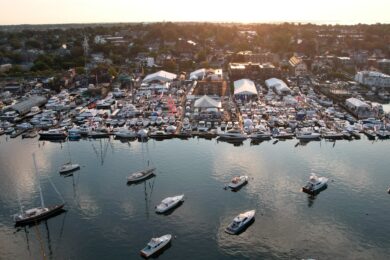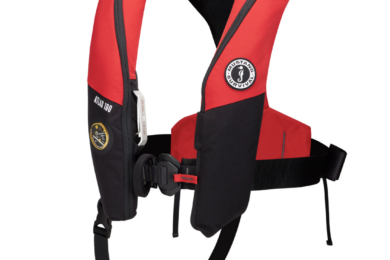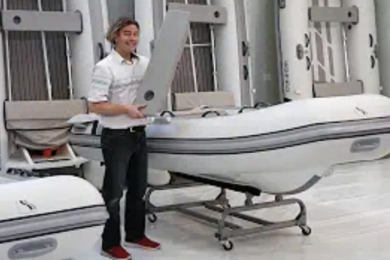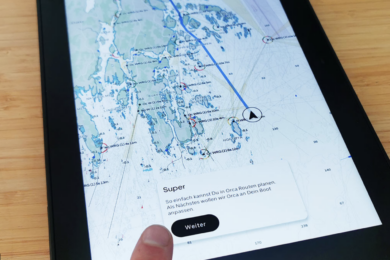The following account was written by veteran cruiser Sheldon Stuchell based on reports from the two crew aboard the cruising boat Escape and official Coast Guard reports. While the incident and the loss of the skipper and his wife, Germans Karl and Annamarie Frank, are alarming, we bring you this report not to be sensational but because the detail that Sheldon is able to provide shows just how quickly a situation at sea can go from normal to a tragedy in a split second, even to experienced sailors who were doing everything in a seamanlike fashion. At the end of this story, we offer Lessons Learned from the two crew aboard Escape and I will posit some thoughts. But, we will not second guess the skipper and his wife; they were experienced sailors who knew what they were doing. GD
This is the personal accounting of the tragedy on S/V Escape by the crew.
On the 2nd of May, 2022, the owners of S/V Escape, a CNB 66 yacht, posted on a crew service web-site, looking for crew to sail with them from Bermuda to Halifax. The responding crew (1 USCG licensed captain; 1 with over fifteen years of sailing experience) had met Annemarie and Karl the year before at a boat show and responded as interested in being crew.
After exchanging emails, and a few video chats, the volunteer crew were invited to help crew the 4-5 day passage to Nova Scotia.
Escape had sailed to Bermuda from St. Martin days later than initially anticipated – delays waiting for parts and servicing the watermaker. This meant they missed an opportunity to participate in a Salty Dawg Spring Rally and would be sailing as an individual boat.
After tropical storm Alex had passed through, there was a narrow weather window between two low pressure systems that Karl and his weather router identified as safe to sail from Bermuda to Nova Scotia. Karl decided on Tuesday evening to set sail Thursday morning informing the crew they needed to arrive in Bermuda by Wednesday. This was a shift from their original plan to have a few day sails around Bermuda to gain familiarity with the vessel and her very particular systems before heading out on the offshore passage.
The crew flew to Bermuda arriving midday Wednesday, the 8th of June. Karl gave the crew (designated as 2nd mate and 3rd mate) a tour of the vessel both top side and below, including locations of all safety equipment (e.g., fire extinguishers, life raft, jacklines, EPIRB, sat phone, sail knife, med kits, electric panels, etc.). He showed the crew locations on the boat he considered not safe, including the area directly around the mainsail sheet attachment forward of the dual helm stations.
Escape pulled up anchor, departing Bermuda precisely as planned at 1000h June 9th. After leaving the channel, they raised the mainsail and genoa in 15 knots of wind, proceeding to sail due North. The 66 ft sloop had a powerful sail plan supported by a carbon fiber mast and carbon fiber V-shaped furling boom. The first 24 hours they made almost 200 nautical miles of progress sailing deep down wind around 150/130 TWA/AWA. One day done, another 3 to 4 days to Nova Scotia.
Given the sail angle, a dyneema preventer was employed and ran back to a winch in the cockpit. For training purposes, the 2nd mate disengaged the autopilot for a couple of hours during the first day to get a good feel for Escape’s dual-rudder helm. That night, when Karl was on watch, some squalls quickly came through and Escape was rounded up.
The 3rd mate assisted in getting all hands on deck per Karl’s command. Karl assigned stations and described the order of operations to reef with Annemarie and the 2nd Mate. This was their first time to reef as a team, it went smoothly and quickly. Annemarie was assigned to the mainsheet, and the 2nd Mate assigned to the helm for steering, while Karl would control the mainsail furling. The mainsheet was anchored to the cockpit deck forward of the steering wheels, up to the boom, and finally back down from the boom to a block that led to a central dedicated electric winch.
A few hours later, despite Escape being stable, the team put in a second reef as winds were steady at 25 knots. It was raining hard with distant lightning. Again, the reefing procedure was well managed without any issues. Note: to reef the mainsail, Karl had to go forward to Escape’s mast where a powered winch controlled the main halyard, and where there were electric and hydraulic button controls for the in-boom mandrel and vang. Similar to most sailboats, Escape had to be turned into the wind to raise or furl the mainsail. The 2nd Mate helmed during each of the reefing operations. Annemarie managed the main sheet.
Conditions during the next 24 hours were milder, winds between 10-18 knots. Sailing downwind even with full sails in these conditions, required Escape to motor for several hours. Karl continued to download weather from PredictWind via IridiumGo and communicated via email with his weather router in Germany. Two and a half days in, the weather and passage were exactly what was predicted. Escape was safely ahead of schedule.
The evening of 11th of June, weather reporting indicated that by midnight or a bit after 0100h Escape would need to begin motoring for the final leg of her passage to Canso, Nova Scotia. Winds were predicted to drop to 12 knots continuing to fall further overnight.
After sunset, the 2nd Mate took the 2100-0100h watch. With winds 18-20 knots Escape was comfortably making 9 knots under full sails. Karl went below to rest for his 0100-0500h watch. Around 2200h, winds began to pick up to 25 knots with gusts near 30 knots. Escape was heeling, more rudder was required to maintain steerage. The 2nd Mate, 3rd Mate, and Annemarie agreed that they should wake Karl to come and reef. Karl looked at conditions and decided to put in one reef. They turned Escape into the wind and reefed smoothly as they had now done at least 5 times. Karl went back to his cabin to rest, and Escape sailed on for another 30 minutes to an hour.
Nearing midnight, contrary to predictions and weather reports, they ran into a storm about 350 Nautical Miles due South of Nova Scotia in the Gulf Stream. The winds steadily increased to 30-35 knots sustained. Sea state worsened with waves around 6 meters. Escape was surfing down waves at 13 knots. Hard rain began. Once again, the 2nd Mate, 3rd Mate, and Annemarie summoned Karl. As he came up on deck, a 40-knot gust began to round Escape up into the wind. The 2nd Mate put the wheel hard over all the way trying to maintain a course. Escape was heeled over, her rail near the water, she was barely holding course.
Karl called out for a second reef. The engine was started, everyone took their normal stations. Karl gave the go signal and the 2nd Mate headed Escape into the wind. Waves now nearing 8 meters were crashing over the deck, her bow was rising high then pitching down. Gulf Stream waves were coming from different directions in the confused seas. Karl was at the controls starting to furl in the Genoa before attending to the main. Annemarie was behind the mainsheet winch, central in the cockpit just ahead of the twin wheels. Annemarie readied the mainsheet in preparation for furling the main. As Escape came into the wind, the 2nd Mate noticed the boom was not centered per usual. During every other reef, the mainsheet was properly tensioned, centering it as Escape turned into the wind. The boom began to swing with the waves. Karl yelled instructions to Annemarie in German (the crew were not German speakers). Karl left the Genoa control lines and ran to the mainsheet winch to help. Annemarie stepped out of the way towards the portside winches.
As Escape was pitching while pointed into the wind her boom swung from starboard all the way to port. The mainsheet struck Annemarie across her back, knocking her to the cockpit sole on the outside edge of the cockpit seating. As the 3rd Mate crawled to help her, Karl, without hesitation, ran to Annemarie. The 2nd Mate yelled to Karl that the boom was swinging back. Escape’s boom swung back, the mainsheet caught and threw Karl to the starboard side, shattering his left leg below the knee, with compound fractures. Within 10 seconds, both of them were seriously injured. As the boom continued to swing, Escape’s mainsheet snapped, and her boom was completely free. At some point the preventer had snapped as well.
Crawling to stay low, the 3rd Mate laid Annemarie flat, pulling her out of harm’s way into the cockpit seating area, trying to keep her still and flat for stability. Loose and tattered sheets were whipping all around. The 3rd Mate then helped pull Karl further from the danger area, and together they made more room to get Annemarie closer and more protected. The 3rd Mate immediately started first aid for Karl grabbing a tether off a lifejacket using it to tie a tourniquet above his knee trying to staunch the bleeding. The 3rd Mate hurried below for medical kits and the EPIRB.
After setting off the EPIRB, the 3rd Mate proceeded to bandage Karl’s lower leg. Next, MAYDAY calls for help over VHF channel 16 were issued. Seeing no one on AIS and getting no response, the 3rd Mate retrieved the satellite phone, handing it to Karl who called for help while the 3rd mate continued radioing over VHF in the event any vessels not appearing on AIS might be in the area.
When Karl made contact, he said they were speaking English passing the satellite phone to the 3rd Mate who managed all communications via the companionway from this point forward. Contact was made with stations initially in Germany, then Halifax, and finally Boston, who worked together relaying information. A request for immediate medical evacuation for the injured was made. A schedule was established for routine check-ins and updates – sea state, wind speeds, boat speed, coordinates, medical, and situational updates were regularly given.
All the while, Escape was out of control. Her genoa and mainsail flapping wildly. The swinging boom started losing loft, first grazing the bimini, ultimately crushing and buckling the bimini’s metal frame. When the boom swung to port and slammed into the shrouds, the 2nd Mate quickly turned Escape east to pin the mainsail/boom against the spreaders and shrouds. Now running with the wind behind them, the end of her boom occasionally submerged in waves throwing it off the shrouds only to slam back. The 2nd Mate was able to gain some stability running downwind, finding the autopilot could sometimes hold for a minute or two until waves rocked Escape and manual piloting was required to prevent an uncontrolled jibe.
The 2nd Mate crawled to the starboard side winches managing to furl the genoa that was now ripped in several places. Returning immediately to Escape’s helm, steering downwind for almost 3 hours lying prone, looking up at the wind indicators atop the mast. The 2nd Mate periodically helped the 3rd Mate tend to Annemarie and Karl. The heavy rain, winds, and seas continued.
Escape was now almost 400 nautical miles offshore, running at 10 knots with the wind and Gulf Stream pushing her further and further East. The 3rd Mate was in regular contact by satellite phone with US Coast Guard and the Canadian Coast Guard in Halifax trying to arrange a rescue. With Escape’s current position so far from land or a rescue ship, Escape was beyond the range and capabilities of an immediate rescue, especially the needed helicopters.
The rescue organizations jointly implemented a plan that was born from serendipity. A USCG Cutter ship just happened to be off the Northeast US shore, but was more than a day away from Escape, which was too far away. The ship also happened to have a good supply of jet fuel aboard. The ship moved and relocated to serve as a lily pad for a helicopter to be able to safely make it out to Escape by refueling in both directions.
While the Cutter navigated to the ideal coordinates, a USCG rescue helicopter flew from their land base to the USCG Cutter with two divers aboard. The helicopter landed on the USCG ship, refueled, then flew directly toward Escape, a process they would repeat on the return trip to land. With every update the 3rd Mate continued to inform Annmarie and Karl that they were one step closer to rescue.
The Crew put another tourniquet on Karl’s leg using a sail tie. They agreed to raise the leg a bit higher onto an additional cushion, adding cushions around him for comfort and stabilization. They also put cushions around Annemarie to stabilize her body with concern of a spinal injury. The 3rd Mate kept supplying Karl and Annemarie with water, covered them with blankets, and gathered whatever they requested both topside and down below to be included in their ditch bag. Karl continued to provide guidance as he could. The 3rd Mate kept them both alert, hydrated, aware of efforts and communicating.
Taking advantage of a brief lull as winds dropped to 15 knots around 0200h, the 2nd Mate attempted to reduce the mainsail while continuing to sail downwind. The 2nd Mate crawled to Escape’s mast and tried to furl the mainsail. There was too much wind pressure, it jammed in the boom furler after a meter or so and could not be lowered further. Hanging on the mainsail, about another meter of sail was pulled down, significantly reducing sail area. The 2nd Mate returned to Escape’s helm, and proceeded to advise everyone to hold on, that he was going to come into the wind and attempt to secure the free boom. The 3rd Mate braced and protected Annemarie and Karl.
Using the engine full throttle, turning the boat and pointing into the wind, the boom often stayed aft and sometimes swung slowly by the midline. After several attempts, the 2nd Mate was able to thread a heavier line from a winch, through the boom loop, quickly lashing the line down to secure Escape’s boom in a centered position, adding additional lines to reinforce it.
At this point Escape was tenuously under control. They changed course to motor West towards land and help. The 3rd Mate called into USCG Boston via Halifax informing them that the boom was under control and requesting a heading West.
A small victory quickly dissipated as the 2nd Mate noticed a line snaking behind Escape in her prop wash. Shifting the engine to neutral, the 2nd Mate grabbed a boat hook, clipped his tether to an outboard connection, and leaned off the aft deck, fishing out the line. Tying the bitter end to the fairlead and calling for the 3rd Mate to assist at the helm, as the 2nd Mate headed to the foredeck. They identified the line as a genoa sheet and pulled the line forward safely away from the propeller. Both crew returned to their respective stations and roles. The crew continued wearing life jackets and were clipped in with tethers at all times when they were on deck and at helm stations.
A USCG C130 airplane was sent in advance of the rescue helicopter and arrived around 0600h to establish clear communications via VHF between Escape and the rescue helicopter. Instructions were given to clear the deck and information was shared regarding sea state, wind speed, state of the boat, boom, mainsail, and the injured. The USCG helicopter arrived around 0630h.
The engine was halted for safety of the divers and the transom was lowered. The first diver dropped from the helicopter, swam over and boarded at the transom, immediately beginning medical care. The 3rd Mate assisted the first diver, while the 2nd Mate assisted with boarding the second diver.
Litter rescue baskets were lowered from the helicopter. Karl and Annemarie were given medical attention, secured into rescue baskets, and lifted to the helicopter. The crew chose to remain on Escape so Annemarie and Karl could be attended to and rushed to care without delay.
Once the helicopter cleared, the crew were instructed to proceed on a heading of 300 degrees to meet the US Coast Guard Cutter. En-route the winds came down and the sea state settled as originally predicted — albeit many hours later.
The crew slowly and incrementally increased speed to what was safe given conditions and continued towards the Cutter’s heading. The 2nd Mate went below to rest while the 3rd Mate took first shift at Escape’s helm, trading off as the day went on, continuing incremental reports to SARS USCG Boston and CCG Halifax. They were informed by satellite phone around 1545h that Karl and Annemarie had not survived. The crew was told Annemarie died upon arrival at the USCG Cutter, and Karl died during helicopter transport from the Cutter to the hospital. Both were pronounced dead upon arrival at the hospital in Massachusetts.
The crew rendezvoused about 350 nautical miles offshore with the USCG Cutter, at approximately 1645h. Escape was boarded, inspected, and secured. Crew were transferred to the Cutter and attended to by the Ship’s Medic. Escape was abandoned at sea as her crew were not in any condition to safely deliver her to port. The Cutter met with a smaller transfer boat about 30 hours later to transfer the crew to the USCG Boston facility for debriefing and interviews. They were dropped off at a hotel shortly before 0200h the morning of 14 June.
Escape was later found adrift by a crew from Publico, Nova Scotia, hired by Leeway Marine of Dartmouth, and brought to Dartmouth Cove, Nova Scotia, Canada.
Lessons Learned
The two crew on Escape offer the following observations in the aftermath of the tragic incident.
It is important to reiterate that it remains unknown exactly what failed. Why was the mainsheet not tensioned? Perhaps the preventer got tangled and fouled the mainsheet, or the electric mainsheet winch failed. We will never know the answer. We can, however, try to learn from this tragedy by summarizing a few key lessons, which may not have been the cause but nonetheless may provide insights into good practices.
Knowledge, familiarity, and experience.
Offshore, especially short-handed, crew should understand how to perform all anticipated and unanticipated maneuvers. Here, the captain was the only crew member who raised or lowered the mainsail. The operation was complicated as it involved a large boom furler with a hidden electric mandrel, a main halyard controlled by an electric winch on the deck near the 100 foot mast, and a hydraulic boom vang with controls at the helm and mast. The main halyard was secured at the mast with an unusual braided textile constrictor clutch, think toy finger cuffs, instead of a traditional clutch or even halyard car on a vertical track. None of the electric/hydraulic buttons or halyards were labeled. On offshore passages, all members of the crew, regardless of their experience, should at the very least be given instruction, if not practice, in how to operate the main controls. Moreover, a language known by all crew should be agreed upon and used during passages. Interacting with the chartplotter and instruments and the satellite phone was difficult for the non-German speaking crew especially when quick actions were required. Understanding what Karl was yelling to Annemarie at that critical moment could perhaps have made a difference, at the very least may have provided an explanation for what went wrong.
Weather amplifies challenges at sea.
Although the crew and boat handled the stormy conditions well the previous night before the tragedy, the dark, sideways rain, howling winds, and waves rocking the boat made every maneuver more challenging. Visibility, the ability to hear one another, and move about the deck with ease all become more difficult. Despite the anticipated weather, the old adage to reef early, especially at night, rings true as ever. The cost of slowing down and later shaking out a reef is nothing compared to the risk of placing crew in danger while being overpowered in the middle of the night. Additionally, in calm seas pointing into the wind will largely center the boom by itself. However, when large waves pitch the boat up and then down, it only takes one big wave for the boom to swing wildly with incredible force. In these conditions, a mistake as simple as standing where one knows is unsafe, if only for a couple of seconds, can be deadly.
Offshore sailing comes with additional risks.
Most of the time sailing offshore is no different than coastal sailing. However, when medical issues arise the distance one is from shore assistance is critical. Sailing on your own, it could take days to reach shore for help. Rescue helicopters have a range of about 500 nautical miles. Specifically, they carry enough fuel to go 250 miles offshore, hover for about 30 minutes for a rescue, then return the 250 miles. Beyond this limit, one should understand that they are on their own, unless part of a rally. Extra safety precautions that one does not normally employ when coastal should be enforced for all crew. This not only includes life jackets and jacklines, but more conservative sailing practices. Training in first aid and CPR, as the crew had, should be standard. Comprehensive first aid supplies and manuals, and pre-packed bags with essentials (e.g., passports, prescriptions, etc.) should be easily accessible. The ability to communicate with shore for help via satellite phone was instrumental in coordinating rescue plans, as was the ability to recharge the phone for prolonged use over many hours.
Further Thoughts from George Day
Sheldon’s report is detailed and thorough. A few thoughts:
First, local weather forecasting for boats at sea, particularly in waters adjacent to strong currents like the Gulf Steam, is problematical. Local weather events may not show up in the data used by the weather models, or may show up late. Keeping a close eye on local information, wind direction and strength, barometer, air temperature, water temperature and radar can fill in any blanks in the models’ forecasts.
Second, a mainsheet on a 66-foot modern sloop with a large mainsail is, as everyone on Escape was aware, a potential threat to the crew, particularly in a rig design that places the anchor for the mainsheet in the middle of the cockpit. Rigging a preventer, as was done, is the prudent action. In configurations such as Escape’s, double preventers or a Boom Brake, can add a belt-and-suspenders redundancy. There is a reason so many modern cruising boats have mid-boom sheeting.
Third, in-boom furling is a great modern innovation in mainsail handling. One of its benefits is supposed to be that if the boom system fails, you can still lower and reef or dowse the sail. Yet, in-boom systems can be finicky, and riggers will often note that the systems are best used by experienced sailors who understand all of the forces at work when handling big mainsails. Certainly, Karl and Annamarie met that standard. The boom is dependent on an exact angle to the mast for reefing and furling and is held in place by an adjustable vang. If the vang is compromised, the system won’t work. Using a topping lift on the end of the boom can be, once again, a belt-and-suspenders redundancy.
Karl and Annamarie were much loved and respected in the cruising community and by their friends and family at home in Germany. We are diminished by their loss.
















